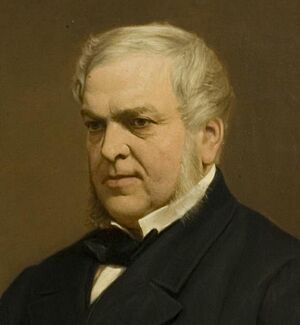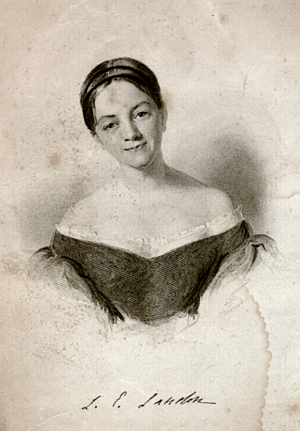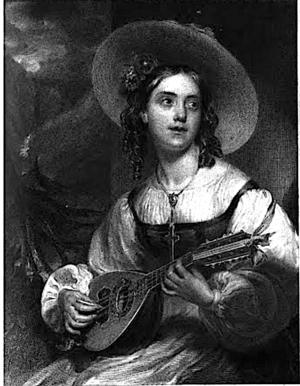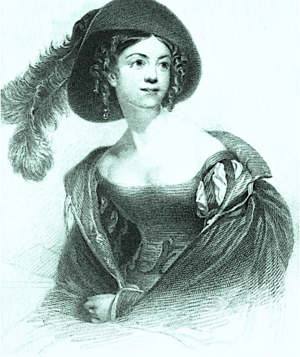Letitia Elizabeth Landon facts for kids
Quick facts for kids
Letitia Elizabeth Landon
|
|
|---|---|
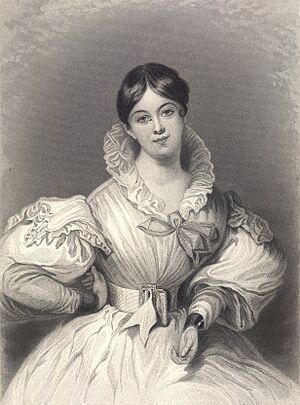
Letitia Elizabeth Landon (1802–1838); variation of the original painting by Daniel Maclise
|
|
| Born | 14 August 1802 Chelsea, Middlesex, England
|
| Died | 15 October 1838 (aged 36) Cape Coast Castle, Ashanti Empire (now in Ghana)
|
| Other names | Letitia Elizabeth Maclean L. E. L. Iole |
| Occupation | writer |
| Known for | Poetry Fiction Reviews |
| Style | Post-Romantic |
| Spouse(s) | |
| Signature | |
 |
|
Letitia Elizabeth Landon (born August 14, 1802 – died October 15, 1838) was a famous English poet and writer. Many people knew her by her initials, L.E.L.
Her writing helped bridge the gap between the Romanticism and Victorian literature styles. Her first big success was a poem called The Improvisatrice. She then developed a new way of writing long poems that influenced other English writers. These included Elizabeth Barrett Browning, Robert Browning, Alfred Tennyson, and Christina Rossetti. She was also very popular in the United States. The famous writer Edgar Allan Poe thought she was a true genius.
After she died, some of her works were not given much attention. This was because of misunderstandings about her personal life.
Contents
Early Life and Learning
Letitia Elizabeth Landon was born on August 14, 1802. Her parents were John and Catherine Jane Landon. They lived in Chelsea, London.
Letitia was a very smart child. She learned to read when she was very young. A neighbor who couldn't move easily would scatter letter tiles on the floor. Letitia would read them and get rewards. Her father said she often brought home many prizes.
When she was five, Letitia went to a school run by Frances Arabella Rowden. Ms. Rowden was a great teacher and a poet. She loved theater and was known for helping her students become poets. Many of her students became famous writers. At this school, Letitia became very good at French.
In 1809, the Landons moved to the countryside. Letitia's older cousin, Elizabeth, taught her at home. Elizabeth soon realized that Letitia knew more than she did. Letitia always knew the right answers to questions about history or books.
Letitia was close to her younger brother, Whittington Henry. He was born in 1804. Letitia started publishing her writing to help pay for his university education. She also supported his career. Later, she wrote a poem for him called Captain Cook. Whittington became a minister and published a book of sermons. Letitia also had a younger sister, Elizabeth Jane, who died at 13.
Becoming a Writer
Starting Her Career: 1820-1834
In 1815, Letitia's family moved back to London. There, her father met William Jerdan. He was the editor of The Literary Gazette. Jerdan noticed young Letitia when he saw her playing outside. She was rolling a hoop with one hand and reading a poetry book with the other. He thought her ideas were "original and extraordinary."
Jerdan encouraged her writing. Her first poem was published in the Gazette in 1820. She was 18 years old. It was signed with just the letter "L." The next year, she published a book of poems called The Fate of Adelaide. She used her full name. The book sold well, but she didn't make any money. The publisher went out of business.
That same month, she published two more poems in the Gazette. This time, she used the initials "L.E.L." These initials became very famous. People wondered who L.E.L. was. Bulwer Lytton said that he and his college friends would rush to get the Literary Gazette every Saturday. They wanted to read the poems by L.E.L. They soon learned she was a woman, which made them even more curious.
Landon became the main reviewer for the Gazette. She also kept writing poetry. She started to combine her love for art with her poems. She wrote poems about decorative letter seals and then about paintings. Her important book, The Improvisatrice; and Other Poems, came out in 1824.
Her father died in 1824. This meant Letitia had to write to support her family. Some people at the time thought it was not proper for a woman to be a professional writer. But her poetry books continued to get good reviews. These included The Golden Violet (1827) and The Venetian Bracelet (1829).
New annual gift books gave her more chances to write about art. These books combined an engraved picture with a poem. She became very good at this. She wrote most of the poems for Fisher’s Drawing Room Scrap Books from 1832 to 1839. Sarah Sheppard, a writer, said that pictures seemed to "speak to her soul." Landon would take a picture and give it "new life" with her words.
Landon also started writing novels. Her first novel, Romance and Reality, came out in 1831. The next year, she published The Easter Gift. This was a book of religious poems that illustrated engravings. In 1834, her second novel, Francesca Carrara, was published.
In July 1834, Landon visited Paris. She met several famous writers there, including Heinrich Heine and Prosper Mérimée.
Engagement to John Forster: 1835-1836
In 1835, Landon became engaged to John Forster. He had some doubts about her reputation at first. These were later cleared up. However, Landon decided to break off the engagement. She said she would never marry a man who had doubted her.
She published another poetry book, The Vow of the Peacock, in 1835. In 1836, she published Traits and Trials of Early Life. This book contained stories and poems for children.
Later Writing Years
In the 1830s, Landon's poetry became deeper and more thoughtful. Some of her best poems appeared in The New Monthly Magazine. These included a series called Subjects for Pictures. In these poems, she explored her goal of writing about inner feelings and thoughts.
In 1837, Landon published another novel, Ethel Churchill. She also started trying new forms of writing. One was a play called Castruccio Castracani. She also worked on a series of Female Portraits of characters from literature. Her last novel was Lady Anne Granard. She started writing it in Africa.
Later Life and Marriage
Landon wanted to leave England. In October 1836, she met George Maclean. He was the governor of the Gold Coast (now Ghana). They began a relationship.
Maclean moved to Scotland the next year, which upset Landon and her friends. After much convincing, Maclean returned to England. He and Landon were married on June 7, 1838. The wedding was private.
Her friend Emma Roberts wrote that Landon admired Maclean's good qualities. She liked his efforts to help the people of Africa. She also admired how he tried to stop the slave trade. Landon felt he was a strong and honest man.
In early July, the couple sailed to Cape Coast. They arrived on August 16, 1838. During her short time in Africa, Landon continued to work on her Female Portrait Gallery. She also finished the first part of her new novel, Lady Anne Granard.
Her Death
Two months later, on October 15, 1838, Landon was found dead. All the European residents attended her burial. William Topp read the funeral service.
What People Thought of Her
Many of Landon's friends and people who knew her described her appearance and personality.
Emma Roberts said that Landon was not strictly beautiful. But her eyes were lovely, and her face was so lively and smart that she was very attractive. She was cheerful and bright. Her clear skin, dark hair, and eyes made her a "sparkling brunette" when she was healthy. Her figure was slim and graceful. She had small hands and feet. These good looks, along with her kind and loving ways, made her very charming.
William Jerdan wrote that she was very unselfish. She always thought about other people's feelings, even when she was troubled herself. She had a sweet and kind nature that never changed. Everyone who knew her loved her.
Anna Maria Hall said that Landon had a special magic. After you remembered all the wonderful things she had written, you forgot about her books. You only felt the joy of being with her. She was understanding and caring. She understood your feelings so well that you wondered how she knew you so easily.
Anne Elwood described Landon's writing room. It was a simple, almost uncomfortable room facing the street. It had a plain white bed. At the foot of the bed was a small, old dressing table. It was covered with a writing desk and papers. Some papers were on the floor because the table was too small. A small, uncomfortable chair and a few books completed her workspace.
Emma Roberts also said that Landon not only read but truly understood every book. She knew a lot about history and literature from all times and places. She didn't just learn things quickly. Her deep knowledge showed in her published works.
Laman Blanchard confirmed that Landon read very quickly. She would read ordinary books much faster than most people. Yet, she understood them completely. She could give a detailed account of a book she barely seemed to have looked at. She could point out problems in the story or characters.
Other people also praised Landon's high intelligence. Fredric Rowton said that her genius was clear. It showed great intelligence, a strong imagination, and intense emotion. He said there was genius in every line she wrote.
Her Reputation
|
"Do you think of me as I think of you, |
| From "L.E.L.'s Last Question," by Elizabeth Barrett Browning (1844) |
Other poets of her time admired Landon. Elizabeth Barrett Browning wrote a poem called "L.E.L.'s Last Question" in her honor. Christina Rossetti also published a tribute poem called "L.E.L." in 1866.
Landon's fame was high in the 1800s. But it decreased in the 1900s. People thought her poetry was too simple or emotional. However, Sarah Sheppard had already addressed this criticism in 1841. She said that people often judged writers without truly understanding their work.
In recent years, scholars have started studying her work more. Critics like Isobel Armstrong argue that the supposed simplicity of her poetry is misleading. They believe that women poets of the 1800s often wrote in ways that had many meanings. Some scholars also suggest that Landon used her writing to establish herself among famous male poets.
Her ideas and different styles of poetry led to a "Landon School" of writing. This influenced writers in England and the United States. William Howitt said that Landon's poetry was unique. You could always recognize her style, even if her name wasn't mentioned.
After Landon's death, The Literary Gazette published a tribute. It said her name would be remembered as one of the brightest in English literature. It predicted that future generations would love her memory. They would cherish her pure and natural early poems. They would also admire her deeper and stronger later works. The tribute ended by saying, "She is gone; and, oh, what a light of mind is extinguished."
Family Details
In 2000, a scholar named Cynthia Lawford found birth records. These records suggested that Landon had children in the 1820s with William Jerdan. More details about her children (Ella, Fred, and Laura) and their families can be found in a book by Susan Matoff.


